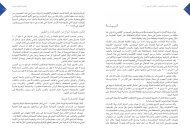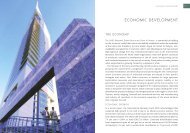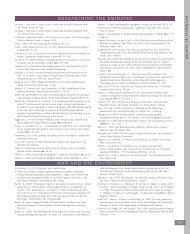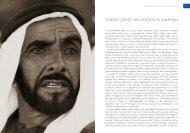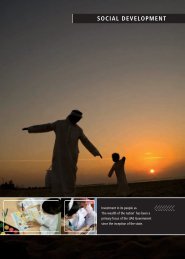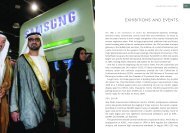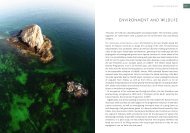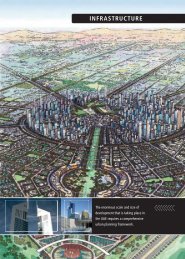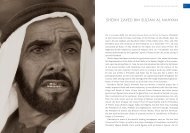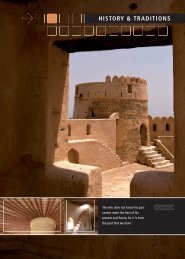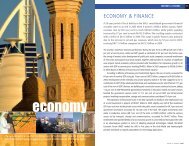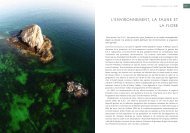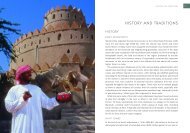You also want an ePaper? Increase the reach of your titles
YUMPU automatically turns print PDFs into web optimized ePapers that Google loves.
<strong>MEDIA</strong> & <strong>CULTURE</strong><br />
The media and culture fields are<br />
undergoing rapid development in the<br />
<strong>UAE</strong>. Consequently some restructuring of<br />
government support has been required.
The National Media Council was established<br />
to oversee media development in the <strong>UAE</strong>.
265<br />
<strong>MEDIA</strong> & <strong>CULTURE</strong><br />
<strong>MEDIA</strong><br />
A REORGANISATION OF GOVERNMENT MINISTRIES IN EARLY 2006 led to the<br />
closure of the Ministry of Information and Culture and to<br />
establishment of a National Media Council and a new Ministry of<br />
Culture, Youth and Community Development. The aim of these<br />
moves was to streamline the different and varied functions that<br />
previously fell under the remit of a single ministry. The Government<br />
also felt that the media and culture fields are both in the process of<br />
rapid development and it was necessary to take a fresh look at how<br />
government support could be most effectively structured.<br />
NATIONAL <strong>MEDIA</strong> COUNCIL<br />
The National Media Council was established to oversee media<br />
development in the <strong>UAE</strong> and to support media initiatives. All<br />
jurisdictions and responsibilities concerning media affairs that<br />
previously fell under the Ministry of Information and Culture were<br />
transferred to the National Media Council. In particular, the core<br />
media bodies of the old ministry, in the form of the Press and<br />
Publications Department, the External Information Department<br />
and the Emirates News Agency (WAM), are now under the authority<br />
of the National Media Council. In addition, the council has the<br />
power to cancel or suspend media licences if there are violations of<br />
conditions attached to these.<br />
The Abu Dhabi-based council is run by a six-member board,<br />
including the chairman, deputy chairman and director general, that<br />
will serve for a term of four years. Sheikh Abdullah bin Zayed Al<br />
Nahyan, Minister of Foreign Affairs, was appointed as Chairman and<br />
Mohammed Abdullah Al Gergawi, Minister of State for Cabinet<br />
Affairs, as his deputy. Other council members include Abdul Rahman<br />
Mohammed Al Owais, Minister of Culture, Youth and Community<br />
Development, Jamal Sanad Al Suweidi, Dr Amina Al Rustamani, Dr<br />
Hassa Lootah and the Director General, Ibrahim Al Abed.<br />
A directive issued at the<br />
end of September 2007<br />
by HH Sheikh<br />
Mohammed bin Rashid<br />
Al Maktoum, Vice<br />
President, Prime<br />
Minister and Ruler of<br />
Dubai, ending the<br />
criminalisation of press<br />
offences gave a great<br />
boost to freedom of<br />
the press in the region<br />
and to the future of<br />
open and independent<br />
journalism.<br />
@www.uaeinteract.com/media
266 U N I T E D A R A B E M I R AT E S Y E A R B O O K 2 0 0 8<br />
The International<br />
Federation of<br />
Journalists (IFJ)<br />
welcomed the directive<br />
decriminalising press<br />
offences and expressed<br />
the hope that a change<br />
in the law in the United<br />
Arab Emirates would<br />
set a precedent for<br />
the decriminalisation<br />
of media law in<br />
the region.<br />
PRESS FREEDOM<br />
A directive issued at the end of September 2007 by HH Sheikh<br />
Mohammed bin Rashid Al Maktoum, Vice President, Prime Minister<br />
and Ruler of Dubai, ending the criminalisation of press offences<br />
gave a great boost to freedom of the press in the region and to<br />
the future of open and independent journalism. The directive<br />
was announced by Sheikh Abdullah bin Zayed Al Nahyan, Minister<br />
of Foreign Affairs and Chairman of the National Media Council, who<br />
underlined Sheikh Mohammed’s view that no journalist should be<br />
imprisoned because of his or her work, pointing out that other<br />
procedures can be taken against any journalist committing an<br />
offence. He added that Sheikh Mohammed had instructed the<br />
Cabinet to speed up the issuing of a new press and publication law<br />
in light of amendments made by the National Media Council in<br />
collaboration with relevant organisations.<br />
The International Federation of Journalists (IFJ) welcomed the<br />
directive and expressed the hope that a change in the law<br />
in the United Arab Emirates would set a precedent for the<br />
decriminalisation of media law in the region.<br />
Following the issuing of the directive, editors-in-chief of some of<br />
the <strong>UAE</strong>'s top Arabic and English newspapers signed a code of<br />
ethics, defining the rights and duties of the press, and outlining their<br />
commitment to raise the standard of journalism in the country.<br />
ABU DHABI <strong>MEDIA</strong> COMPANY<br />
Abu Dhabi Law No. 13 for 2007 provided for the establishment of<br />
Abu Dhabi Media Company (ADMC), a Dh100 million public joint<br />
stock company wholly owned by the government of Abu Dhabi.<br />
Mohammed Khalaf Al Mazrouei was appointed as Chairman of<br />
ADMC, Ahmed Ali Al Sayegh, as Deputy Chairman, and Mohammed<br />
Omer Abdullah, Mubarak Hamad Al Muhairi and Abdullah Muslih Al<br />
Ahbabi, as members of the board.<br />
The law defines the company's role in carrying out all mediarelated<br />
activities, including broadcasting, production, marketing,<br />
advertisement and other associated services, plus provision of<br />
media services via the internet or any other medium and publishing
M E D I A & C U LT U R E<br />
267<br />
of newspapers and magazines in Arabic and other languages. The<br />
company's duties also cover the fostering and training of <strong>UAE</strong><br />
nationals in all media.<br />
Under the law, ownership of Abu Dhabi Satellite Channel, Abu<br />
Dhabi Sport Channel, Abu Dhabi Radio, Emarat FM Radio, Holy<br />
Quran Radio, Al Ittihad newspaper, Zahrat Al Khaleej magazine,<br />
Al Super magazine and Majid magazine, (all previously owned by<br />
Emirates Media Incorporated, EMI) was transferred to ADMC,<br />
along with all their assets. The broadcasting group's coverage<br />
extends from the Middle East to Europe and North America.<br />
In a major development in September 2007, Abu Dhabi Media<br />
Company forged a strategic alliance with Aldar Properties and<br />
Warner Brothers Entertainment governing the creation of a theme<br />
park and hotel, jointly owned multiplex cinemas, a co-finance<br />
agreement covering feature film production and the development<br />
and publication of videogames, and the build-out of the infrastructure<br />
for Abu Dhabi's digital transformation. Foreign Minister Sheikh<br />
Abdullah bin Zayed Al Nahyan stressed that the alliance ‘is a clear<br />
testimony that Abu Dhabi has positioned itself as a hub for culture,<br />
media and entertainment. The new deal is poised to enhance the<br />
image of Abu Dhabi as a world-class cultural destination,’ he said.<br />
The ADMC also announced in mid-2007 plans to launch a new<br />
English language daily newspaper, based in Abu Dhabi. To be<br />
edited by a former editor of the London Daily Telegraph, the<br />
newspaper, whose title had not been announced as this Yearbook<br />
went to press, is expected to be launched early in 2008. A previous<br />
Abu Dhabi-based English language daily, Emirates News, part of the<br />
EMI group, ceased publication in early 1999, leaving the English<br />
language media dominated by publications from Dubai and Sharjah,<br />
and the launch of the new Abu Dhabi title is expected to result in<br />
increased coverage of news from the <strong>UAE</strong>'s capital city.<br />
ADMC,Aldar Properties<br />
and Warner Brothers<br />
have formed a<br />
strategic alliance,<br />
positioning Abu Dhabi<br />
as a centre for<br />
culture, media<br />
and entertainment.<br />
EMIRATES NEWS AGENCY<br />
Emirates News Agency, (WAM or Wakalat Anba'a al-Emarat) began<br />
operations in 1976. Since mid-2006 it has been under the authority<br />
of the National Media Council. The agency transmits news on<br />
@www.uaeinteract.com/media
national, regional and Arab affairs and is a widely respected source<br />
for international media. WAM is a member of the Group of Arab<br />
Gulf Cooperation Council news agencies, the Federation of Arab<br />
News Agencies (FANA), the Islamic News Agencies Union, the Pool<br />
of Non-Aligned News Agencies and the Organisation of Asia-Pacific<br />
News Agencies (OANA). Its headquarters is in the <strong>UAE</strong> capital, Abu<br />
Dhabi, with other offices in Dubai, Sharjah, Ajman, Umm al-<br />
Qaiwain, Ra's al-Khaimah, Fujairah, Al Ain and Madinat Zayed.<br />
WAM maintains a team of around 25 reporters outside the <strong>UAE</strong>,<br />
with offices in the Arab cities of Cairo, Beirut, Rabat, Riyadh,<br />
Damascus, Sanaa, Algiers, Jerusalem, Gaza, Khartoum, Amman,<br />
Baghdad and Tunis. Other offices and reporters are located in<br />
London, Paris, Brussels, Geneva, Moscow, Washington, New York,<br />
Tehran, Islamabad, New Delhi, Istanbul and Canberra. The agency<br />
also operates a website with services in both Arabic and English.<br />
Since it was established, WAM has kept abreast of changes in<br />
technology and now distributes its news and picture services by<br />
satellite and internet, both locally and internationally. Over 90 per<br />
cent of its photographs are available in digital format, which has<br />
helped both to improve efficiency and to cut costs.
M E D I A & C U LT U R E<br />
269<br />
WAM provides daily news coverage of official and other events<br />
throughout the United Arab Emirates and is one of the key sources<br />
of information for all media establishments in the country. It<br />
provides coverage of around 85 to 90 per cent of official activities<br />
at home and abroad. In addition, WAM plays an important role in<br />
documenting development in the <strong>UAE</strong>, and in providing information<br />
to researchers and others.<br />
WAM receives the transmissions of 30 Arab, Gulf and international<br />
news agencies and has cooperation and news exchange agreements<br />
with 20 Arab, Asian and international news agencies, part of an<br />
effort to strengthen collaboration between the media of the <strong>UAE</strong> and<br />
other countries.<br />
Meanwhile, WAM, via a central news portal run by IPS, relays<br />
daily news in English, Spanish, French, Portuguese and Swahili<br />
languages to over 1000 newspapers and 2000 broadcast stations<br />
worldwide. A weekly <strong>UAE</strong> news digest in Japanese has also been<br />
added to the agency's news services. The IPS news portal can be<br />
accessed on www.ipsnews.net, while WAM's daily English news as<br />
well as selected news service in Spanish, Portuguese, Swahili and<br />
Japanese languages are relayed over the internet.<br />
WAM organises regular training workshops as part of a long-term<br />
strategy for building the professional capacities of its editors and<br />
those working for other media outlets.<br />
WAM receives the<br />
transmissions of 30<br />
Arab, Gulf and<br />
international news<br />
agencies and has<br />
cooperation and news<br />
exchange agreements<br />
with 20 Arab,Asian and<br />
international news<br />
agencies, part of an<br />
effort to strengthen<br />
collaboration between<br />
the media of the <strong>UAE</strong><br />
and other countries.<br />
DUBAI <strong>MEDIA</strong> CORPORATION<br />
HH Sheikh Mohammed bin Rashid Al Maktoum appointed a new<br />
board of directors to Dubai Media Corporation in April 2007: Ahmed<br />
Abdullah Al Sheikh is the new DMC Managing Director, while the<br />
other board members include Sami Da'en Al Ghamzi, Mona Al<br />
Merri, Ahmed Obeid Al Mansouri, Joseph Ghassoub, Dr Amina<br />
Al Rustamani, Raja Al Morad, Abdul Kadir Obeid Ali and Faisal<br />
Abdullah Abdul Rahman.<br />
The board is entrusted with the task, among other responsibilities,<br />
of preparing DMC’s operational strategy and developing the<br />
appropriate structures to enable DMD to discharge its mission in a<br />
transparent and objective manner.<br />
@www.uaeinteract.com/media
270 U N I T E D A R A B E M I R AT E S Y E A R B O O K 2 0 0 8<br />
The 2007 Arab<br />
Journalism Awards<br />
were presented to Arab<br />
media personalities and<br />
publications on the<br />
concluding day of the<br />
Arab Media Forum.<br />
HH Sheikh Mohammed bin<br />
Rashid Al Maktoum at the<br />
Arab Media Forum 2007.<br />
ARAB <strong>MEDIA</strong> FORUM<br />
Inaugurated by Dubai Press Club in 2001, the annual Arab Media<br />
Forum is designed to open channels of dialogue between Arab and<br />
Western media in order to promote better understanding.<br />
The Arab Media Forum 2007 was held at Madinat Jumeirah in<br />
April. The two-day event was built around the theme of ‘Developing<br />
People, Developing Organisations’ with experts highlighting the<br />
importance of training and retraining media professionals to meet<br />
the challenges of the information and technology explosion. The<br />
2007 Arab Journalism Awards were presented to Arab media<br />
personalities and publications on the concluding day of the Arab<br />
Media Forum.<br />
RADIO & TV<br />
The <strong>UAE</strong> has over 20 radio stations – more than any other country<br />
in the Arab world. In addition to the channels now owned by<br />
ADMC, including Abu Dhabi Radio, Emarat FM Radio, Holy Quran<br />
Radio, there are radio stations based in Dubai, Umm al-Qaiwain<br />
Ajman and Fujairah.<br />
Viewers in the <strong>UAE</strong> have access to over 200 satellite channels<br />
and more than 40 television stations broadcast from the <strong>UAE</strong>, a<br />
number that is steadily increasing. Abu Dhabi is a dominant force<br />
in the country's broadcasting profile with three major satellite<br />
channels in operation, including ADMC’s Abu Dhabi Satellite<br />
Channel and Abu Dhabi Sport Channel.<br />
FILM<br />
In recognition of the significant role films can play in promoting<br />
the culture and heritage of the <strong>UAE</strong> and the region, ADACH signed<br />
a memorandum of understanding (MoU) on 26 June 2007 with<br />
New York Film Academy to establish a world-class film and acting<br />
school devoted to developing the film industry in the <strong>UAE</strong>. The<br />
Abu Dhabi Film Academy, which is set to open in January 2008,<br />
will assist ADACH to foster and support regional artistic talent<br />
and to create an environment conducive to strong cultural and<br />
artistic expression.
M E D I A & C U LT U R E<br />
271<br />
Prior to the collaboration with the New York Film Academy, there<br />
was already a focus on film in Abu Dhabi and an awareness of<br />
the role the visual medium plays in society. One notable contributor<br />
was Masoud Amralla Al Ali, Artistic Director of the <strong>UAE</strong> Cultural<br />
Foundation and a world expert on Arab cinema. Al Ali founded the<br />
influential Emirates Film Competition, which is based at the Cultural<br />
Foundation and currently in its sixth year.<br />
In line with the government’s active encouragement of local and<br />
international filmmakers through the Abu Dhabi Film Commission<br />
and the Abu Dhabi Film Academy, the first Middle East International<br />
Film Festival was held in Abu Dhabi from 14 to 19 October 2007<br />
with over 100 films from 38 countries competing for the coveted<br />
Black Pearl awards. Writing master-classes organised by the Film<br />
Financing Circle with Oscar-winner Paul Haggis, events bringing<br />
together international financiers and film chiefs to create new<br />
filmmaking opportunities in the Middle East, and a focus on films by<br />
Arab women directors were some of the highlights of the festival.<br />
The Film Commission is very keen to showcase regional film at<br />
major international festivals and at the same time inform the world<br />
about the benefits of filming major productions, such as the recently<br />
launched ‘The Kingdom’, in Abu Dhabi. The long-term, multi-faceted<br />
strategic alliance formed between Aldar Properties, Abu Dhabi<br />
Media Company and Warner Brothers Entertainment in September<br />
2007 will also have a profound impact on the development of the<br />
film industry in Abu Dhabi (see above).<br />
Masoud Amralla Al Ali was appointed in 2007 as Artistic Director<br />
of the very successful Dubai International Film Festival (DIFF), now<br />
in its fourth year. DIFF has as its theme, 'Bridging Cultures, Meeting<br />
Minds', and sees its role not only as a cultural ambassador of the<br />
<strong>UAE</strong> on a global level but also as a catalyst for future development<br />
of the film industry in the country. As well as showcasing local talent<br />
and introducing the <strong>UAE</strong> to world cinema, DIFF operates as a<br />
platform for networking between <strong>UAE</strong> and international filmmakers,<br />
producers and sales agents, bringing in the region of 1000 industry<br />
representatives from across the globe to Dubai. This not only<br />
benefits local talent, it also feeds into the nascent movie industry<br />
working out of Dubai Studio City free zone.<br />
Presented by ADACH,<br />
the first Middle East<br />
International Film<br />
Festival launched the<br />
Film Financing Circle,<br />
which will become<br />
a significant annual<br />
conference on<br />
international<br />
co-productions.<br />
@www.uaeinteract.com/media
272 U N I T E D A R A B E M I R AT E S Y E A R B O O K 2 0 0 8<br />
According to the<br />
Business Software<br />
Alliance (BSA), the <strong>UAE</strong><br />
has posted the lowest<br />
software piracy rate in<br />
the region for the past<br />
ten years, and is the<br />
only Middle East entry<br />
to the worldwide list of<br />
20 nations with the<br />
lowest piracy rates.<br />
PRINTING, PUBLISHING AND ADVERTISING<br />
The <strong>UAE</strong> is the regional hub for the publishing, printing and<br />
advertising industries and is expected to receive the largest single<br />
share of the estimated US$1.7 trillion worth of business that is<br />
predicted for this sector in the Middle East by 2008. As a result,<br />
the <strong>UAE</strong> printing industry is expanding by 15 to 20 per cent<br />
annually with total worth estimated between Dh8 to Dh10 billion.<br />
Approximately 500 printing presses are operating in the country,<br />
many of which are expanding due to the high proliferation of local<br />
and foreign publications.<br />
Advertising expenditure in the Gulf has been growing at 15<br />
per cent per year. This is hardly surprising in an area with a high<br />
net-worth tax-free consumer base. The <strong>UAE</strong> has about 400<br />
advertising agencies, but 90 per cent of the business is controlled<br />
by the top 20 companies, including the world's leading names.<br />
Standards are rising steadily in this booming market as recent<br />
creativity awards attest.<br />
In particular, <strong>UAE</strong> agencies won multiple prizes in the first-ever<br />
Dubai Lynx awards organised by the Cannes Lions International<br />
Advertising Festival in association with the <strong>UAE</strong> chapter of the<br />
International Advertising Association. In subsequent years Dubai<br />
Lynx will be run alongside a new event ‘The Dubai International<br />
Advertising Festival’, which will commence in 2008, bringing a<br />
series of high profile seminars and other initiatives aimed at<br />
giving creative inspiration, learning and networking opportunities<br />
to people working in the region. Entries will be invited from<br />
throughout the Middle East and North Africa region.<br />
INTELLECTUAL PROPERTY RIGHTS<br />
The Government operates a strict enforcement policy of its copyright,<br />
piracy and patent laws, seeing the protection of creativity as a<br />
necessity in itself and essential to attracting foreign investment. A<br />
member of the World Intellectual Property Organisation (WIPO),<br />
the <strong>UAE</strong> acceded to the Paris Convention for the Protection of<br />
Industrial Property in 1996, following the implementation of three<br />
intellectual property laws in 1993.
The Government also works hand in hand with the Trade Mark<br />
Owners Council (TMOC) to strengthen the protection of intellectual<br />
property rights at the state level as the initiatives launched under<br />
the banner ‘Supporting Innovation’ marking World Intellectual<br />
Property Day indicate.<br />
According to the Business Software Alliance (BSA), the <strong>UAE</strong> has<br />
posted the lowest software piracy rate in the region for the past ten<br />
years, and is the only Middle East entry to the worldwide list of 20<br />
nations with the lowest piracy rates. Although government and<br />
business initiatives have curbed the spread of software piracy,<br />
growing consumer demand threatens to erode that progress. Not<br />
satisfied with this situation, the <strong>UAE</strong> authorities have stepped up<br />
efforts to further reduce software piracy levels in the country and<br />
have reinforced their association with BSA. Proposed measures<br />
include organising more awareness campaigns to create better<br />
understanding of the detrimental impact of software piracy, and<br />
ensuring rigorous enforcement of IPR and copyright laws.<br />
A study on this subject<br />
pointed out that by<br />
bringing piracy down<br />
in the <strong>UAE</strong> by ten<br />
percentage points, the<br />
country could generate<br />
more than 667 new<br />
jobs and result in an<br />
additional Dh1.31<br />
billion (US$357 million)<br />
in contributions to the<br />
<strong>UAE</strong>'s GDP.<br />
@www.uaeinteract.com/media
274 U N I T E D A R A B E M I R AT E S Y E A R B O O K 2 0 0 8<br />
Creativity City is the<br />
latest project under the<br />
administration of the<br />
recently formed<br />
Fujairah Culture and<br />
Media Authority<br />
(FCMA). It will be<br />
operated and<br />
administered by<br />
Fujairah Media.<br />
CNN Building in<br />
Dubai Media City.<br />
A study on this subject pointed out that by bringing piracy down<br />
in the <strong>UAE</strong> by ten percentage points, the country could generate<br />
more than 667 new jobs and result in an additional Dh1.31 billion<br />
(US$357 million) in contributions to the <strong>UAE</strong>'s GDP. With the help<br />
of a ten-point reduction in its 34 per cent software piracy rate, the<br />
IT sector could grow to nearly Dh8.44 billion (US$2.3 billion) by<br />
2009, creating new business opportunities for entrepreneurs and<br />
new jobs opportunities for employees.<br />
<strong>MEDIA</strong> ZONES<br />
The <strong>UAE</strong>'s first media free zones, Internet City and Media City in<br />
Dubai, have been a resounding success, so much so that demand<br />
for space exceeds the available places. A new entry to the market,<br />
the 4-million-square-metre International Media Production Zone<br />
(IMPZ), in which Dh1 billion (US$272 million) was invested in the<br />
first phase, will cater to the printing, packaging and publishing<br />
sectors. Investment in the second phase, which comprises mainly<br />
offices, will approach Dh700 million (US$190 million).<br />
Work will soon commence on a 40,000-square-metre media<br />
free zone Creativity City in Fujairah catering for individuals and<br />
companies working in the media, communications, design and<br />
technology fields. As well as new investors, Creativity City will<br />
contain a number of already existing ventures such as Fujairah FM.<br />
Initial plans are for two sites.<br />
Creativity City is the latest project under the administration of the<br />
recently formed Fujairah Culture and Media Authority (FCMA). It<br />
will be operated and administered by Fujairah Media, a joint<br />
venture between Fujairah Investments – the investment arm of the<br />
Government of Fujairah – and Arab International Media Services.<br />
The <strong>UAE</strong> Cabinet decided at its meeting on 18 March 2007 that all<br />
free zones in the <strong>UAE</strong> are obliged to obtain the written approval<br />
of the National Media Council before the issuance of any media<br />
licences related to radio and television broadcasting activities and<br />
the publication of newspapers, magazines, periodicals and books.<br />
The Cabinet also indicated that all other related media activities<br />
in the free zones should comply with the effective relevant laws<br />
and regulations.
PUBLICATIONS<br />
The <strong>UAE</strong> Government supports the production of a number of<br />
special books each year. In addition to publications prepared by<br />
individual ministries, dealing with matters of special interest, the<br />
<strong>UAE</strong> Yearbook is an annual publication produced in cooperation<br />
with the National Media Council. This unique series, of which the<br />
present volume forms a part, is published in Arabic, English, and<br />
French. The book covers a wide range of topics on the United<br />
Arab Emirates and seeks to focus attention on developments over<br />
the previous 12 months. The <strong>UAE</strong> Yearbook is accompanied by a<br />
booklet on the <strong>UAE</strong> and a DVD-rom containing a range of media<br />
resources on the country, in addition to several e-books.<br />
<strong>UAE</strong>INTERACT<br />
The website <strong>UAE</strong> <strong>Interact</strong> (www.uaeinteract.com) was one of the<br />
first to carry daily news stories on the <strong>UAE</strong> and has been in<br />
continuous operation for 11 years. All stories posted to the website<br />
are categorised by subject area and archived with the result that<br />
the site contains a huge database of searchable articles on the<br />
United Arab Emirates going back as far as 1997. Each year, new<br />
features are added and revisions are made to keep pace with fastchanging<br />
technologies.<br />
A major upgrading of the website began in early 2007. This<br />
included the addition of nine languages, Russian, Japanese,<br />
Mandarin Chinese, Korean, Spanish, French, German, Italian and<br />
Portuguese, to bring the total number of languages accessible on<br />
the site to ten. These satellite websites are updated on a weekly<br />
basis and they contain a wide range of comprehensive information<br />
on the country, together with translated versions of the popular film<br />
on the Emirates: Creative Energy – Shaping the Emirates.<br />
Meanwhile, an interactive mapping and routeing system has<br />
been added to the main site, facilitating the planning of journeys<br />
throughout the seven emirates, and other new features are in the<br />
pipeline. <strong>UAE</strong> <strong>Interact</strong> is consistently listed by Google as the second<br />
most significant website after Wikipedia on the world wide web<br />
under the search word '<strong>UAE</strong>'.<br />
The <strong>UAE</strong> Yearbook is<br />
accompanied by a<br />
booklet on the <strong>UAE</strong> and<br />
a DVD-rom containing<br />
a range of media<br />
resources on the<br />
country, in addition to<br />
several e-books.<br />
<strong>UAE</strong> <strong>Interact</strong> is the official<br />
website of the National Media<br />
Council and is produced in ten<br />
languages.<br />
@www.uaeinteract.com/media
276 U N I T E D A R A B E M I R AT E S Y E A R B O O K 2 0 0 8<br />
<strong>CULTURE</strong> & HERITAGE<br />
The Government’s<br />
objective is to ensure<br />
that economic growth<br />
results in the<br />
conservation and wider<br />
dissemination rather<br />
than the diminishment<br />
of the country’s cultural<br />
heritage, which is<br />
worthy of special<br />
protective measures<br />
not only on the basis of<br />
its local significance<br />
but also because it<br />
contributes to the<br />
richness of global<br />
culture and heritage.<br />
Preservation of national values, culture and heritage are inextricably<br />
linked with national identity, knowledge of which provides a firm<br />
footing for the development of a secure and stable society at ease<br />
with its place in the modern world. The Government’s objective<br />
is to ensure that economic growth results in the conservation and<br />
wider dissemination rather than the diminishment of the country’s<br />
cultural heritage, which is worthy of special protective measures<br />
not only on the basis of its local significance but also because it<br />
contributes to the richness of global culture and heritage. However,<br />
as Abu Dhabi Executive Council Policy Agenda 2007/2008 points<br />
out, without the appropriate intervention, cultural resources are<br />
threatened with dilution by rapid urban, demographic and<br />
economic development.<br />
ABU DHABI AUTHORITY<br />
Preservation of culture is one of the core areas of interest of the<br />
recently established Abu Dhabi Authority for Culture and Heritage<br />
(ADACH), an independent culture heritage management body<br />
whose brief is to promote, preserve and regulate the rich tangible<br />
and intangible cultural heritage of the emirate. ADACH has total<br />
responsibility for the management of the emirate’s complex<br />
cultural heritage sector, including its rich resource of archaeological<br />
and palaeontological sites, unique cultural landscape, traditional<br />
architecture, oral and written expression, customs and handicrafts.<br />
In the words of Abu Dhabi’s State of the Environment report: ‘its<br />
formation has created the opportunity for improved integrated<br />
cultural resource management and, in so doing, has brightened the<br />
sector’s outlook. The lack of adequate legislation at local as well as<br />
federal levels has hindered the protection of cultural resources. Until<br />
very recently, no single authority has had the mandate to manage<br />
cultural resources. Instead, various organisations undertook this<br />
work largely on an ad hoc and unplanned basis’.<br />
In this context, ADACH held a series of consultation workshops<br />
in 2007 to assist in drafting a law to protect, regulate and manage
Abu Dhabi Authority for Culture and<br />
Heritage is an independent heritage<br />
management body whose brief is<br />
to promote, preserve and regulate<br />
the rich tangible and intangible cultural<br />
heritage of the emirate.
278 U N I T E D A R A B E M I R AT E S Y E A R B O O K 2 0 0 8<br />
ADACH is also<br />
working closely with<br />
international<br />
organisations such as<br />
UNESCO with a view to<br />
sustainable<br />
development of its<br />
assets in harmony with<br />
the growing value of<br />
cultural tourism.<br />
cultural heritage in the Emirate of Abu Dhabi. The new law will<br />
enhance the role of ADACH, but it will be wider in scope than Law<br />
No. 8 of 1970 governing archaeological affairs, which it will replace.<br />
In the meantime, ADACH is gathering detailed and reliable baseline<br />
information on Abu Dhabi’s cultural heritage in order to assess<br />
its condition and establish appropriate planning and protection<br />
mechanisms. At the same time, it is developing the necessary<br />
procedures to regulate and monitor archaeological excavations, and<br />
is working in close collaboration with federal and local authorities<br />
involved in the implementation of culture and heritage policy.<br />
To fulfil its mandate: ‘ADACH will coordinate with a range of public<br />
and private entities, including the Abu Dhabi Tourism Authority,<br />
as cultural and natural heritage is central to the Government’s<br />
ambitious tourism strategy and the positioning of the Emirate as<br />
a unique Arabian destination; the Department of Transport, as<br />
efforts to promote culture and heritage sites will rely on the ability<br />
of the transport system to get people to and from the sites<br />
conveniently; Ministry of Education, Abu Dhabi Education Council<br />
and individual Education Zones to ensure local culture and heritage<br />
is taught appropriately in schools and higher education institutions,<br />
through a formal curriculum or other resources; private property<br />
developers to ensure new real estate and property developments<br />
consider the impact on natural and cultural heritage, ensure cultural<br />
and heritage assets are protected and also enable the promotion of<br />
these assets as resident and tourist attractions.’<br />
ADACH is also working closely with international organisations<br />
such as UNESCO with a view to sustainable development of its<br />
assets in harmony with the growing value of cultural tourism.<br />
MINISTRY OF <strong>CULTURE</strong>, YOUTH AND COMMUNITY DEVELOPMENT<br />
Education and cultural preservation as a solid foundation for a<br />
confident, outward-looking people sure of their national identity are<br />
also central themes in the 2008/2010 strategic framework unveiled<br />
by the Ministry of Culture, Youth and Community Development.<br />
The ministry's plans mirror the key objectives of the <strong>UAE</strong> Federal<br />
Government Strategy, which places a special emphasis on innovation<br />
and creativity in youth as a major catalyst for development.
M E D I A & C U LT U R E<br />
279<br />
The recently launched <strong>UAE</strong> National Cultural Encyclopaedia, which<br />
will help document the nation's cultural heritage, is one of the<br />
ministry's most important current initiatives in furtherance of its<br />
brief. The ministry's other plans include a number of strategic<br />
partnerships with federal and local organisations to celebrate cultural<br />
endeavours across the country and promote contributions by the<br />
local community.<br />
In March 2007 the <strong>UAE</strong> Cabinet formally decided to set up a<br />
National Council for Tourism and Antiquities under the aegis<br />
of the ministry. The council will oversee the development of<br />
archaeological and historical sites in the country with a view to<br />
making them more accessible to the public.<br />
DUBAI STRATEGIC PLAN<br />
The Dubai Strategic Plan 2015, which dovetails with the federal<br />
government strategy, also stresses the need to increase awareness<br />
of local culture and strengthen the sense of belonging. Proposals<br />
have been put forward to promote cultural life in Dubai by upgrading<br />
the cultural sector’s regulatory framework; increasing awareness<br />
and interest in Dubai's cultural activities; encouraging and nurturing<br />
national talent; developing high-quality facilities, including theatres,<br />
movie houses and museums, to attract international art and culture<br />
events; and encouraging and supporting the initiatives of the private<br />
sector that aim at enhancing the cultural and artistic momentum.<br />
The Dubai Strategic<br />
Plan 2015, which<br />
dovetails with the<br />
federal government<br />
strategy, also stresses<br />
the need to increase<br />
awareness of local<br />
culture and strengthen<br />
the sense of belonging.<br />
Proposals have been<br />
put forward to promote<br />
cultural life in Dubai<br />
by upgrading the<br />
cultural sector’s<br />
regulatory framework.<br />
CULTURAL INNOVATION<br />
The Government’s commitment to keep alive the <strong>UAE</strong>’s rich heritage<br />
and culture benefits <strong>UAE</strong> society in many ways, not least of which<br />
is the direct economic gain from defining the country as a cultural<br />
destination, albeit one that is also taking on ‘an international mantle’<br />
as the country is coming of age. This is nowhere more evident than<br />
in the development of Saadiyat Island, which is the cornerstone<br />
of Abu Dhabi’s ambitious plans to develop the emirate’s tourism<br />
potential, with cultural tourism, this time with an added global twist,<br />
being the driving force behind the imaginative project.<br />
Saadiyat’s Cultural District will contain a series of spectacular<br />
innovative buildings designed by some of the world’s leading<br />
@www.uaeinteract.com/media
280 U N I T E D A R A B E M I R AT E S Y E A R B O O K 2 0 0 8<br />
A powerful new<br />
cultural agency, the<br />
French Museums<br />
Agency, has also been<br />
established to steer the<br />
development of the<br />
planned Louvre<br />
Abu Dhabi.<br />
architects: Frank Gehry’s Guggenheim Abu Dhabi contemporary art<br />
museum, Tadao Ando’s Maritime Museum, Jean Nouvel’s Louvre<br />
Abu Dhabi, and Zaha Hadid’s Performing Arts Centre.<br />
At 30,000 square metres, the Abu Dhabi museum will be the only<br />
Guggenheim in the Middle East and North Africa region and will be<br />
larger than any existing Guggenheim worldwide. The museum,<br />
which will be completed by 2012, will form its own major collection<br />
of contemporary art and will also exhibit masterworks from the<br />
Guggenheim Foundation’s global collections.<br />
On 6 March 2007, the Abu Dhabi government and the French<br />
Government entered into an historic 30-year cultural agreement<br />
to establish the Louvre Abu Dhabi, which will exhibit major<br />
artefacts in archaeology, fine and decorative arts from all periods,<br />
but focusing on the classical era. The agreement provides for longterm<br />
loans from the Louvre and other major French museums.<br />
Temporary exhibitions will also be organised annually and will be<br />
included in the programme of international exhibition exchanges<br />
between major international museums.<br />
A powerful new cultural agency, the French Museums Agency,<br />
has also been established to steer the development of the planned<br />
Louvre Abu Dhabi. The agency, headed by Marc Ladreit de<br />
Lacharriére, publisher of the periodical Revue des Deux Mondes,<br />
will collaborate with the Tourism Development and Investment<br />
Company (TDIC). Former Centre Pompidou executive director<br />
Bruno Maquart will serve as executive director of the new agency,<br />
which is expected to supply expertise in the areas of restoration,<br />
curatorship and exhibition design, as well as provide training for<br />
the museum operating body that will be in charge of the Louvre<br />
Abu Dhabi. The long-term goal is to see <strong>UAE</strong> nationals fully trained<br />
in these specialist fields.<br />
The district will also contain a new heritage museum in honour of<br />
the late Sheikh Zayed bin Sultan Al Nahyan, the design of which<br />
has yet to be decided from submissions by 13 of the world's top<br />
architectural practices. The Saadiyat cultural district will also house<br />
a Biennale Park with 19 pavilions devoted to culture and the arts.<br />
The latter, which will not be built until the last phase of the Saadiyat’s<br />
master plan in 2017, is loosely based on the Venice Biennale.
The architecture of the Cultural District and the island itself<br />
constitutes a bold cultural statement. To quote Frank Gehry:<br />
‘There’s a great opportunity for infrastructure to be designed here<br />
rather than just engineered. It’s not been done anywhere in the<br />
world since the 19 th century. It’s never happened in contemporary<br />
times, perhaps the odd bridge here and there that’s beautiful, but<br />
they have an opportunity here to make a statement and not just<br />
with individual buildings, but as an entire coherent city’.<br />
OPERA, MUSIC & ART<br />
Abu Dhabi’s international cultural profile has not been placed on<br />
hold until Saadiyat’s Cultural District is constructed. In the<br />
meantime, the emirate is playing host to cultural undertakings<br />
that will help position Abu Dhabi as the region's cultural and<br />
entertainment capital, such as the Middle East premiere of AIDA<br />
Monumental Opera on Fire, which was performed in the open air<br />
on 29 March 2007 at the lavish West Park garden in Emirates<br />
Palace Hotel in Abu Dhabi in association with the Abu Dhabi<br />
Tourism Authority (ADTA), and Georges Bizet's world renowned<br />
opera, Carmen, staged from 8 to 11 November 2007 under the<br />
patronage of Sheikh Mansour bin Zayed Al Nahyan, Minister of<br />
An artist’s impression of a<br />
completed Saadiyat Island<br />
development shows the new<br />
Cultural District in the<br />
foreground. The project is<br />
expected to draw considerable<br />
international attention to Abu<br />
Dhabi as a major destination.<br />
The architecture of the<br />
Cultural District and the<br />
island itself constitutes<br />
a bold cultural<br />
statement. To quote<br />
Frank Gehry: ‘There’s a<br />
great opportunity for<br />
infrastructure to be<br />
designed here rather<br />
than just engineered’.<br />
@www.uaeinteract.com/media
282<br />
U N I T E D A R A B E M I R AT E S Y E A R B O O K 2 0 0 8<br />
Al Ain Classical Music<br />
Festival is a yearly event<br />
featuring classical<br />
music concerts of<br />
a high artistic standard.<br />
Al Ain Classical Music Festival.<br />
Presidential Affairs. Emirates Palace Hotel also showcased cultural<br />
and artistic masterpieces from Russia in the Kremlin exhibition.<br />
The Abu Dhabi Music Foundation brings top artists and orchestras<br />
from Europe and elsewhere to Abu Dhabi and is also instrumental<br />
in organising the Al Ain Classical Music Festival, a yearly event<br />
featuring classical music concerts of a high artistic standard by<br />
internationally acclaimed orchestras and artistes. The festival has<br />
managed to attract consistently larger crowds, but plans announced<br />
recently for the city, including the setting up of an arts and cultural<br />
complex (see below), will enable the festival to expand with the<br />
ability to host the best of Arabic and Western orchestras and<br />
musicians at various historical sites in the city.<br />
International performers are also regularly featured in Dubai,<br />
particularly at Theatre Madinat Jumeirah and Media City<br />
amphitheatre. In addition, plans for an Opera House in Dubai are<br />
under discussion. Supported by the Dubai Cultural Council, which<br />
sponsors and develops cultural infrastructure in Dubai, the proposed<br />
opera house will be built on a man-made island in the Creek.<br />
International and regional visual artists were to the forefont also<br />
in 2007. Sharjah, which was designated UNESCO Cultural Capital<br />
of the Arab World in 1998, has a long history of involvement with<br />
the arts. Sharjah Biennial 8, held from 4 April to 4 June 2007,<br />
entitled Still Life: Art, Ecology and the Politics of Change, presented<br />
attempts by visual arts and film to address the growing social,<br />
political and environmental challenges of the world. The biennial<br />
not only provided a venue and a platform for presentations,<br />
exhibits and discussions, but also actively commissioned artists to<br />
produce new work corresponding to the topic at hand to stimulate<br />
wider involvement with the issues.<br />
Organised in conjunction with ADACH and Abu Dhabi’s Tourism<br />
Development Investment Corporation (TDIC), artparis – abu dhabi<br />
art fair featured modern and contemporary masterpieces as well as<br />
an extensive collection of Arabian art at an exhibition and sale that<br />
took place from 26 to 29 November 2007. Based on a similar event<br />
that is held annually at the Grand Palais in Paris, 47 European and<br />
international art galleries exhibiting more than 3000 works of 700
M E D I A & C U LT U R E 283<br />
artists from all over the globe registered their participation in the<br />
prestigious event. Among the paintings on display were masterpieces<br />
by Pablo Picasso, Salvador Dali, Marc Chagall and Joan Miro.<br />
While the entire collection was conservatively valued at over US$400<br />
million (Dh1.4 billion), there was something for all enthusiastic art<br />
collectors and art lovers, including informative seminars on art<br />
appreciation and how to invest in art.<br />
Dubai’s cultural profile was considerably enhanced by the<br />
staging of DIFC Gulf Art Fair from 8 to 10 March 2007 at the<br />
Jumeirah Madinat arena, bringing together a very fine collection<br />
of contemporary and modern art from 50 of the world’s top art<br />
galleries for the region’s first major international art fair. In addition,<br />
the fair featured an excellent education programme and a forum<br />
for artists, collectors, curators, artists and philanthropists to express<br />
their views on art in the Middle East. The fair, which has been<br />
renamed Art Dubai, will take place from the 19 to 22 March 2008.<br />
CULTURAL FOUNDATION<br />
The Cultural Foundation has long been a cultural oasis in the<br />
centre of the capital. Enjoyed by young and old, <strong>UAE</strong> citizens and<br />
expatriates alike, the main building is a dramatic white structure<br />
resplendent with arches and colonnades, within which are lecture<br />
halls, libraries and meeting rooms, as well as ample space on its<br />
three floors for displays and exhibitions. Fountains play in an open<br />
courtyard and the whole structure is surrounded by leafy gardens.<br />
Perhaps the most important part of the Cultural Foundation is<br />
the National Library, which has well over a million books, most in<br />
Arabic, although there are also collections in a variety of foreign<br />
languages. Most of these are available for consultation by the public,<br />
once a simple registration process has taken place. However, some<br />
of the rarer items, including a fine collection of Qur’ans, can only be<br />
examined with special permission.<br />
A dedicated children’s section is particularly popular and an openplan<br />
area occupies much of the ground floor, this being used on<br />
a regular basis for exhibitions, which include national and<br />
international art exhibitions, displays of old photographs of the<br />
The Cultural<br />
Foundation has long<br />
been a cultural oasis in<br />
the centre of the<br />
capital, enjoyed by<br />
young and old,<br />
<strong>UAE</strong> citizens and<br />
expatriates alike.<br />
Traditional henna painting on<br />
hands.<br />
@www.uaeinteract.com/media
284 U N I T E D A R A B E M I R AT E S Y E A R B O O K 2 0 0 8<br />
International theatre is<br />
frequently staged in<br />
Madinat Jumeirah,<br />
whilst Dubai<br />
Community Theatre and<br />
Arts Centre in the Mall<br />
of the Emirates is the<br />
venue for plays,<br />
musicals, lectures,<br />
classes and art<br />
exhibitions for the local<br />
community, mostly<br />
appealing to a largely<br />
expatriate population.<br />
Emirates, handicrafts, archaeological artefacts and a wide range<br />
of other items. There are also rooms on the first floor suitable for<br />
smaller events and an area outside the tastefully designed restaurant<br />
is dedicated to the sale of local handicrafts.<br />
The two large theatres are used for a range of cultural activities,<br />
including classical music concerts, some staged by the Abu Dhabi<br />
Music Foundation; film shows, including regular film seasons from<br />
individual countries or directors; plays, and film festivals (see below).<br />
The Emirates Natural History Group, the <strong>UAE</strong>’s oldest environmental<br />
non-governmental organisation, has held its open meetings in the<br />
Cultural Foundation on a twice-monthly basis for 20 years. Other<br />
voluntary groups also make use of the facilities, including a<br />
gardening group and chess enthusiasts.<br />
THEATRE<br />
The first play was staged in the <strong>UAE</strong> about 50 years ago and a<br />
Theatrical Association was formed in 1971. In order to give a muchneeded<br />
boost to the indigenous theatre industry, which has been<br />
stagnating for some time, ADACH cooperated with the Theatrical<br />
Association to stage a two-week theatrical season commencing<br />
with the opening of Al Buqsha at the Cultural Foundation in July<br />
2007. All the plays, most focus on social issues and massive<br />
changes in traditions and lifestyle, had previously been staged at<br />
the Sharjah Theatre Festival in April. Sharjah already hosts a lively<br />
theatrical community and the association opened two new branches<br />
in Fujairah and Abu Dhabi in September 2007.<br />
International theatre is frequently staged in Madinat Jumeirah,<br />
whilst Dubai Community Theatre and Arts Centre in the Mall of the<br />
Emirates is the venue for plays, musicals, lectures, classes and art<br />
exhibitions for the local community, mostly appealing to a largely<br />
expatriate population.<br />
EMIRATES HERITAGE CLUB<br />
A number of organisations in the <strong>UAE</strong> are entrusted with the task<br />
of preserving and dissemminating the country’s heritage to the<br />
young generations that would otherwise be unfamiliar with the
M E D I A & C U LT U R E<br />
285<br />
customs and traditions of their ancestors. One of the most<br />
committed is Emirates Heritage Club (EHC), which organises<br />
heritage exhibitions, oversees heritage centres and collaborates<br />
with all other <strong>UAE</strong> institutions sharing the same interests. Activities<br />
organised by the club for all age groups not only cover traditional<br />
sports such as camel racing, boat racing, falconry, and traditional<br />
skills like tent-building and coffee-making, but also contemporary<br />
sailing, equestrian, shooting and other sports. EHC is instrumental<br />
in organising competitive events in these fields, as well as youth<br />
camps on the island of Al Sammaliah, north-east of Abu Dhabi City.<br />
Heritage research is conducted through EHC’s affiliate, the Zayed<br />
Centre for Heritage and History in Al Ain, and environmental<br />
research through the Department of Environmental Research<br />
(DER) on Al Sammaliah. DER is primarily concerned with coastal<br />
biodiversity, conservation and sustainable development of coastal<br />
habitats. EHC formed the Amateur Astronomers Group (AAG) in May<br />
1998 to spread astronomy awareness among all categories of<br />
society. Another affiliate, Emirates Sailing Academy (ESA-ESS),<br />
was set up in July 2000.<br />
THE EMIRATES CENTRE FOR STRATEGIC STUDIES<br />
AND RESEARCH<br />
The ECSSR, founded in 1994 in Abu Dhabi, is an independent<br />
institution dedicated to the promotion of academic research and<br />
empirical enquiry. ECSSR serves as a focal point for scholarship on<br />
political, strategic, military, environmental, economic, and social<br />
issues pertinent to the <strong>UAE</strong>, the Gulf, and the greater Middle East<br />
through the sponsorship of research and studies conducted by<br />
scholars from around the globe.<br />
The core of its work lies in identifying and analysing issues of vital<br />
significance, predicting future trends and devising management<br />
strategies to cope with such issues. As well as maintaining and<br />
training its own staff of researchers, it hosts conferences, symposia,<br />
workshops and lecture series renowned for the eminence of the<br />
participants and the quality of their content and influence. Integral<br />
to the success of ECSSR’s research programme are the annual<br />
Emirates Heritage Club<br />
helps to preserve<br />
traditional sports such<br />
as camel racing, boat<br />
racing and falconry.<br />
Lt. General Sheikh Saif bin<br />
Zayed Al Nahyan, Minister of<br />
Interior, addressing the Annual<br />
Conference of the Emirates<br />
Centre for Strategic Studies<br />
and Research.<br />
@www.uaeinteract.com/media
286 U N I T E D A R A B E M I R AT E S Y E A R B O O K 2 0 0 8<br />
The core of ECSSR's<br />
work lies in identifying<br />
and analysing issues of<br />
vital significance to the<br />
<strong>UAE</strong> and the region.<br />
Trend Assessment Reports prepared in the centre’s various units<br />
which, by providing a survey of major international and domestic<br />
developments and their possible implications, become a powerful<br />
tool in the task of prioritising the goals for the following year.<br />
The ECSSR’s publishing activities have made it a major source of<br />
specialised scholarly publications in the region. As well as publishing<br />
monographs in its International Studies Series, it also publishes the<br />
proceedings of conferences, symposia and lectures in Emirates<br />
Occasional Papers (an English series) and Strategic Studies (an Arabic<br />
series). In addition to these and other publications, ECSSR translates<br />
into Arabic works of importance to the centre and its audience, both<br />
regionally and globally.<br />
Recent publications include books such as With United Strength,<br />
an authoritative biography of the late Sheikh Zayed bin Sultan Al<br />
Nahyan; The Three Occupied <strong>UAE</strong> Islands: The Tunbs and Abu Musa;<br />
The Long Road from Taif to Jeddah: Resolution of Saudi-Yemeni<br />
Boundary Dispute; Iraq: Reconstruction and Future Role. The Gulf Oil<br />
and Gas Sector: Potential and Constraint is one of the latest<br />
publications in the ECSSR Energy Conference series. Earlier titles<br />
have covered issues such as Gulf oil in the aftermath of the Iraq<br />
War, risk and uncertainty in the changing global energy market<br />
and the dynamics and trends of Asian energy markets. The latest<br />
book in the ECSSR Annual Conference series is Arab Media in the<br />
Information Age. Topical issues covered earlier in the series include<br />
the impact of the information revolution on Arab society, educational<br />
challenges confronting the Arab world, leadership and management<br />
techniques in the information age and human resource development<br />
in a knowledge-based economy.<br />
Other titles are Education Technologies and Their Impact on the<br />
Educational Process: A Case Study of the Faculty of Humanities<br />
and Social Sciences (FHSC), <strong>UAE</strong> University; Governance and<br />
Globalization: An Economic Perspective; In the Shadow of Just Wars:<br />
Violence, Politics and Humanitarian Action; NATO's Growing Role<br />
in the Greater Middle East; The Religious Right and US Middle East<br />
Policy; and The Role of Water Exports in Iranian Foreign Policy<br />
Towards the GCC states.
M E D I A & C U LT U R E<br />
287<br />
SULTAN BIN AL OWAIS FOUNDATION<br />
The Dubai-based Sultan Bin Ali Al Owais Cultural Foundation was<br />
established in 1988 under the umbrella of the <strong>UAE</strong> Association of<br />
Writers and Men of Letters. The foundation became an independent<br />
cultural institution in 1992. Its objectives include fostering Arab<br />
talent and culture by presenting biennial awards for poetry,<br />
fiction, drama and literary criticism, in addition to a ‘Cultural and<br />
Scientific Achievement Award’.<br />
HISTORIC BUILDINGS<br />
There has long been an awareness that historic buildings are<br />
cultural assets of the nation that should be preserved to provide<br />
a touchstone for future generations and a window into the world<br />
of yesterday.<br />
Spearheaded by ADACH, Abu Dhabi’s oldest building is set to<br />
become a cultural heart for the nation following a multi-million<br />
dirham project. Qasr Al Hosn, also known as the White Fort, will<br />
become a repository and museum depicting all aspects of <strong>UAE</strong><br />
culture and a place for all Emiratis to celebrate national triumphs.<br />
The fort was originally built as a watchtower to guard a waterhole in<br />
1761, becoming a fully fledged fort on what is now Abu Dhabi Island<br />
in 1793 when the site was settled. It remained as the residence of<br />
the Al Nahyan family until 1966, when Sheikh Zayed bin Sultan Al<br />
Nahyan became the first ruler to live outside its walls. Since then, the<br />
fort has first housed the emirate’s police and, later, the Centre for<br />
Documentation and Research, which has now moved to a purposebuilt<br />
complex that also houses the national archives.<br />
Al Ain has a full complement of impressive forts and heritage<br />
structures, including the Eastern Fort, located within the compound<br />
of Al Ain Museum; Murabba Fort, which used to be the police<br />
headquarters and a prison; and Jahili Fort, the latter a large restored<br />
fort in the city centre that has a distinctive corner turret with four<br />
levels or terraces. ADACH is creating a data centre here, which will<br />
include an exhibition of old photographs of the Al Ain area, as well<br />
as information about heritage and cultural sites, government offices<br />
and cultural activities in the city.<br />
There has long been an<br />
awareness that historic<br />
buildings are cultural<br />
assets of the nation<br />
that should be<br />
preserved to provide<br />
a touchstone for future<br />
generations and<br />
a window into the<br />
world of yesterday.<br />
@www.uaeinteract.com/culture
288 U N I T E D A R A B E M I R AT E S Y E A R B O O K 2 0 0 8<br />
Over on the East Coast,<br />
at Kalba, an enclave of<br />
Sharjah, the former<br />
house of the local<br />
ruling family has been<br />
carefully restored, as<br />
has a rectangular<br />
Islamic fort nearby,<br />
while work is also<br />
under way on the<br />
restoration of a larger<br />
fortress at Khor Kalba,<br />
which may rest on the<br />
site of a fort build by<br />
the Portuguese in the<br />
fifteenth century AD.<br />
Fujairah Fort has been<br />
recently restored.<br />
A purpose-built cultural centre is also planned for the Qattarah<br />
oasis, Al Ain, while a number of historic buildings are being restored<br />
that can be used for cultural activities, such as hosting visiting artists<br />
and cultural evenings, thereby contributing to the development of<br />
cultural tourism in Al Ain. The renovation of two historic buildings,<br />
the Hadi Al Darmaki house and the Al Jahili mosque, has been<br />
completed in accordance with the international standards laid down<br />
by UNESCO, and the refurbishment of Al Ain Museum and Al Ain<br />
Palace Museum is now under way.<br />
Dubai intends to restore over 300 historic buildings in the<br />
emirate by 2010 as part of the government's architectural<br />
conservation plans. Where appropriate, buildings will be submitted<br />
for inclusion to UNESCO's approved list of heritage sites. At least<br />
three historic districts in Dubai, Shindagha, Bastakia and Hatta<br />
Heritage Village, are already under consideration by UNESCO. The<br />
Shindagha area alone contains around 65 heritage sites, whilst Al<br />
Bastakia has around 55 heritage sites, over half of which have been<br />
restored. Amongst these buildings are Sheikh Saeed house – an<br />
elegant late nineteenth century, two-storey building of Arabic design,<br />
complete with four wind towers, housing a unique collection of rare<br />
coins, photographs, stamps and documents; Bait Al Wakeel –<br />
Dubai’s first office building dating back to 1934 and now housing a<br />
museum devoted to Dubai’s fishing and maritime traditions; Al<br />
Ahmadiya School – Dubai’s first regular school, established in 1912<br />
and now a museum of education.<br />
The restored Al Fahidi Fort in Dubai was originally the ruler’s<br />
residence; it subsequently became an arsenal, then a jail, and is now<br />
a thriving interactive museum with a wide range of archaeological<br />
and ethnographic exhibits. Dubai Municipality’s old headquarters<br />
has also been re-opened as a museum following a renovation<br />
programme. The two-storey building, which offers glimpses of local<br />
history, was originally built in the mid-1950s.<br />
Historic buildings in Dubai are also used for commercial<br />
purposes to generate some income and support their restoration.<br />
A hotel is being run in one of the restored buildings, while others<br />
are used for restaurants and coffee shops. Some of the restored<br />
buildings have also been rented out for residential purposes.
M E D I A & C U LT U R E<br />
289<br />
Sharjah’s renovation and restoration of architecturally acclaimed<br />
heritage buildings and an old souq in the Sharjah Arts Area<br />
and Sharjah Heritage Area have earned it international acclaim.<br />
Many of these fine buildings house art, Islamic and ethnographic<br />
museums, including the country’s first national art gallery, and one<br />
is also home to The Emirates’ Fine Arts Society. Nearby is Sharjah<br />
Fort or Al Husn. Built by Sheikh Sultan bin Saqr Al Qasimi in 1820,<br />
this carefully renovated fort was the residence of the ruling family<br />
for many years. It was torn down in 1969, but the present ruler,<br />
himself a prominent local historian, has restored it with the help<br />
of old photographs and documents, his own notes and the<br />
assistance of elderly residents. It now houses a museum. Al<br />
Mahatah Fort at the old airport site right in the centre of Sharjah<br />
displays aviation memorabilia.<br />
Over on the East Coast, at Kalba, an enclave of Sharjah, the former<br />
house of the local ruling family has been carefully restored, as has<br />
a rectangular Islamic fort nearby, while work is also under way on<br />
the restoration of a larger fortress at Khor Kalba, which may rest on<br />
the site of a fort built by the Portuguese in the fifteenth century AD.<br />
The eighteenth century fort in Ajman switched in 1970 from<br />
being the ruler’s palace and office to housing the local police force.<br />
In 1981, it changed function once again to become a museum<br />
displaying an interesting collection of archaeological artefacts,<br />
manuscripts, old weapons and reconstructions of traditional life.<br />
Situated alongside Umm al-Qaiwain's Creek, its main gates<br />
flanked by two impressive old cannons, Umm al-Qaiwain Fort,<br />
formerly the ruler’s residence but now restored as a museum, is one<br />
of the most atmospheric in the <strong>UAE</strong>. The upper floor includes a highceilinged<br />
majlis (a meeting room and a place to receive guests)<br />
elegantly decorated with carved wooden balconies. The lower level<br />
is occupied by a cooking area and store rooms.<br />
The beautifully renovated Ra’s al-Khaimah Fort behind the<br />
Police Headquarters on Al Hosn Road in the old town was the<br />
residence of the ruling family until the early 1960s and houses an<br />
intriguing collection of archaeological and ethnological artefacts,<br />
although plans are being drawn up for the construction of a<br />
purpose-built museum.<br />
The beautifully<br />
renovated Ra’s al-<br />
Khaimah Fort behind<br />
the Police Headquarters<br />
on Al Hosn Road in the<br />
old town, was the<br />
residence of the<br />
ruling family until the<br />
early 1960s.<br />
Traditional windtowers<br />
provided natural cooling.<br />
@www.uaeinteract.com/culture
290 U N I T E D A R A B E M I R AT E S Y E A R B O O K 2 0 0 8<br />
Fujairah’s Department<br />
of Archaeology and<br />
Heritage recently<br />
completed the<br />
renovation of another<br />
major site at Awhala in<br />
southern Fujairah,<br />
where a Late Islamic<br />
fort sits on top of the<br />
foundations of a much<br />
larger Iron Age fortress.<br />
An important series of surveys has been undertaken in Ra’s al-<br />
Khaimah Emirate over the years, documenting mountain villages,<br />
towers, mosques, the old houses of the palm gardens of Al Nakheel<br />
and Shimal, and the traditional buildings of Ra’s al-Khaimah City.<br />
Archaeologists from the Ra’s al-Khaimah National Museum are<br />
researching and cataloguing all traditional structures and the more<br />
important of them are being earmarked for restoration.<br />
The Emirate of Fujairah also has its fair share of historic<br />
buildings, particularly impressive forts and other defensive structures<br />
on the coast and traditional routes through the major wadis. Work<br />
by the Department of Archaeology and Heritage on the restoration<br />
of Fujairah Castle, begun in the late 1990s, was completed in 2000,<br />
while many of the adjacent buildings, including walled courtyardhouses<br />
once occupied by members of the ruling family, have also<br />
been restored. The whole area is to be surrounded by a new wall,<br />
within which a number of new buildings will be constructed to act<br />
as a focus for the heritage of Fujairah. These are expected to include<br />
a three-storey museum, an amphitheatre, a souq, a mosque, a<br />
restaurant and a children’s play area.<br />
The department recently completed the renovation of another<br />
major site at Awhala in southern Fujairah, where a Late Islamic fort<br />
sits on top of the foundations of a much larger Iron Age fortress.<br />
Work also commenced on restoration of the Late Islamic palace and<br />
adjacent buildings in Wadi Hayl, around 13 kilometres west of<br />
Fujairah City. Once the residence of a junior branch of the ruling<br />
family, this is one of the best-preserved sites of its type in the whole<br />
of the <strong>UAE</strong>.<br />
WORLD HERITAGE SITE<br />
ADACH’s Cultural Landscapes division has indicated that the<br />
Jebel Hafit area near Al Ain, a region of outstanding natural<br />
beauty with an abundance of archaeological sites, could become<br />
the <strong>UAE</strong>’s first UNESCO World Heritage Site. The summit of the<br />
1240-metre mountain is accessed by a 11.7 kilometre-winding<br />
road with breathtaking views. The rocky outcrop and surrounding<br />
area is home to popular hot springs, cave formations, as well as<br />
endangered wildlife, and boasts a restored fort and archaeological
uins at nearby Mezyad, in addition to ancient stone tombs that<br />
date back thousands of years.<br />
The UNESCO scheme has the backing of the Environment<br />
Agency – Abu Dhabi (EAD) as well as government officials. However,<br />
although the <strong>UAE</strong> is working closely with UNESCO, a formal<br />
application cannot be processed until the <strong>UAE</strong> passes a federal law<br />
regulating cultural heritage.<br />
A model shows how the<br />
Louvre – Abu Dhabi will<br />
look upon its completion.<br />
MUSEUMS<br />
In addition to the large number of historic buildings that house<br />
museums, which have already been discussed, the <strong>UAE</strong> has a rich<br />
selection of purpose-built, modern museums dedicated to specific<br />
subject areas, such archaeology, natural history, science, popular<br />
medicine, astronomy, numismatics, philately, Islam, traditional<br />
jewellery, policing and aviation.<br />
Sharjah is well known for its museums, heritage and environment<br />
centres, which include a number of world-class displays, not only<br />
of local interest but also dealing more broadly with the culture<br />
@www.uaeinteract.com/culture
292 U N I T E D A R A B E M I R AT E S Y E A R B O O K 2 0 0 8<br />
The Breeding Centre is<br />
focusing on the<br />
breeding of endangered<br />
Arabian species<br />
with the hope of<br />
re-introducing some<br />
of the rarer species<br />
into the wild.<br />
and science of the Islamic world. Sharjah Museums Department<br />
oversees and coordinates the many museums in the emirate in<br />
order to foster a fertile environment for their future development<br />
and consolidate Sharjah's reputation as an attractive cultural and<br />
leisure destination.<br />
Sharjah's Planetarium specialises in astronomy and celestial<br />
navigation; its Police Museum has a good collection of armaments,<br />
riot and combat gear and models of old walls and forts; its<br />
Archaeological Museum is a modern, lively interactive museum<br />
tracing the history of Sharjah from ancient times; the Science<br />
Museum has 50 excellent interactive exhibits covering physics,<br />
chemistry, biology and astronomy; whilst the Discovery Centre is<br />
the first interactive ‘hands-on’ children’s museum in the <strong>UAE</strong> and<br />
a very popular venue. Meanwhile, the grounds of Sharjah Desert<br />
Park contain the Natural History Museum, a Children’s Farm, the<br />
Arabian Wildlife Centre and the Breeding Centre for Endangered<br />
Arabian Wildlife.<br />
Sharjah’s Natural History Museum opened in 1995 and was<br />
immediately very popular because of its state-of-the-art exhibits.<br />
Lively with light and sound effects as well as interactive video<br />
displays, the exhibits deal with local habitats, plant and animal<br />
life, geology and marine life. Outside are wildflower and formal<br />
gardens. The Arabian Wildlife Centre is an impressive modern zoo<br />
that displays local wildlife in their natural habitats. Most of the<br />
displays can be viewed from inside an enormous climate-controlled<br />
building. Exhibits include a reptile house, a huge aviary with freeflying<br />
birds as well as rock-hopping hyrax, a night house with<br />
many desert mammals, an ‘Ibex Mountain’ overlooked by the<br />
restaurant, and a corridor with huge windows looking out onto<br />
enclosures for hamadryas baboons and large predators such as<br />
wolves, cheetahs and the Arabian leopard.<br />
The Breeding Centre is focusing on the breeding of endangered<br />
Arabian species with the hope of re-introducing some of the rarer<br />
species into the wild. This is where, for the first time in the <strong>UAE</strong>,<br />
captive breeding of the Arabian leopard was achieved. For obvious<br />
reasons, this particular centre is not open to the public.



